Jatiluwih’s carefully carved terraces are among the most beautiful rice terraces on the planet and thanks to Bali’s complex irrigation system, the Subak System, they are also a UNESCO world heritage site.
We think they are the best rice terraces in Indonesia and that’s no mean feat when you consider that rice is the Indonesian Archipelago’s staple food and they grow a lot of rice in the rice fields of Indonesia.
Our guide will show you what you can expect at the stunning rice terraces of Jatiluwih and what you can do, where you can eat and where to stay if you want to spend a night or two in the lush rice paddies.
Where Is Jatiluwih Rice Terraces?

The Jatiluwih Rice Terraces are somewhat “in the middle of nowhere” and you can find them around the Jatiluwih Village in the Penebel District of the Tabanan Regency.
It’s about a 2-hour drive from any of the main tourist destinations in Bali including the beach towns of Canggu, Seminyak, Kuta, and Legian and the capital city Denpasar.
Address: Village, Jl. Jatiluwih Kawan No.Desa, Jatiluwih, Kec. Penebel, Kabupaten Tabanan, Bali 82152, Indonesia
How Do I Get To Jatiluwih Rice Terraces?
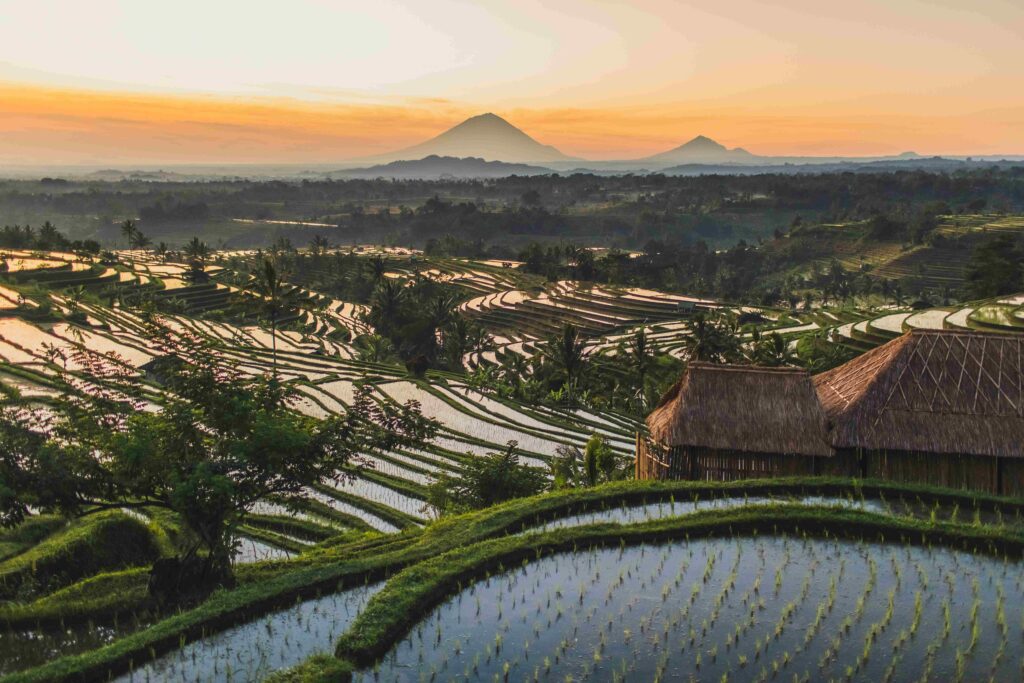
There are really only three ways to get to Jatiluwih Rice Terraces and we only recommend two of them:
Private car and driver – it’s very easy to rent a car with a local driver in Bali and it’s cheap. This is a very convenient way to get around because it means you don’t have to deal with the traffic or road conditions, someone with experience can handle it. It also means that you can stop wherever you want along the way and explore to your heart’s content. If you want to set your own pace and itinerary on a day out to the Jatiluwih rice terraces, this is the way to go.
An organized day trip or tour – if you really want to understand the Jatiluwih rice terraces and the irrigation system here, as well as the local culture, etc. then it can be a great idea to join an organized tour. This will probably cost a little more than hiring a driver, but you get a guide as part of the deal.
Scooter – you can rent a scooter in Bali cheaply and it’s a convenient way to get around the island but we never recommend doing this. The roads are maintained badly, the driving standards here are poor to abysmal and even experienced riders struggle to cope with the conditions. It’s also difficult to be road-legal and if you don’t get road-legal, your insurance is invalid. It’s best to avoid huge hospital bills and stick to cars and coach tours.
Why not Grab or Go-jek? We love Bali’s ride-sharing apps and we’re huge fans of using them to get around, but, Jatiluwih Rice Terraces are in the middle of nowhere. Grab and Go-jek might get you to the terraces but you’re not going to find it easy (and it may well be impossible) to find a ride home again.
When Is The Best Time To Visit Jatiluwih Rice Terraces?
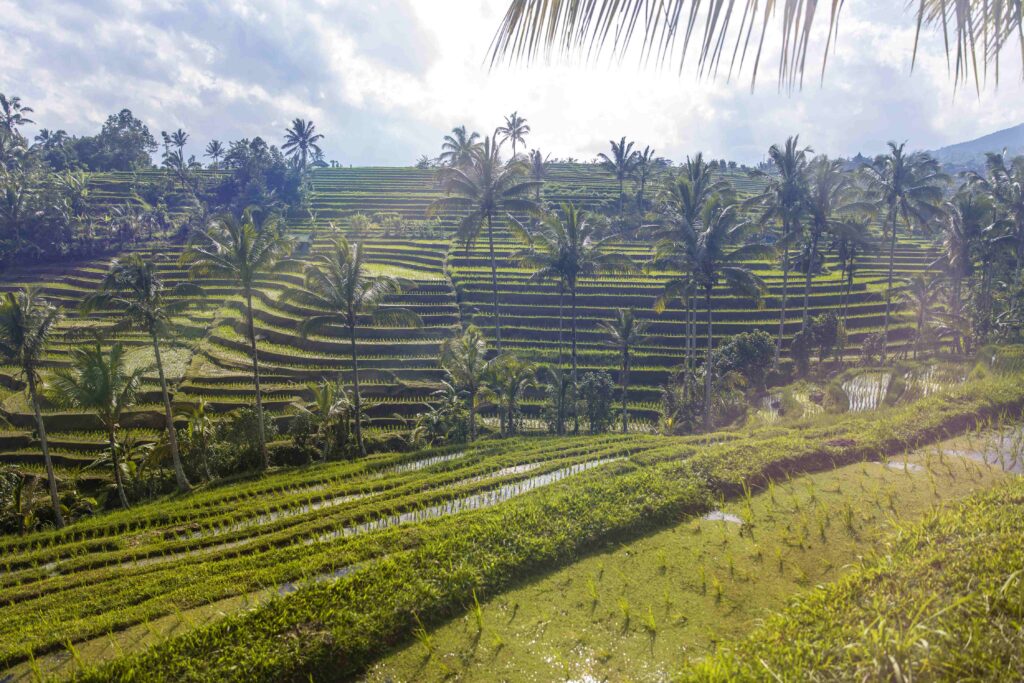
Rice fields and rice paddies are only good to look at when they’re growing and thriving. That means the best time to visit the Jatiluwih Rice Terraces is in Bali’s rainy season between February and April.
If you arrive during the dry season, you’re more likely to find brown muddy fields than vibrant rice terraces.
However, if you arrive during harvest in May and June, you may find you learn more about the local agricultural system than if you’d arrived to just watch the rice fields in bloom, as it were.
The Jatiluwih Rice Terraces cover such a huge area that you really don’t have to worry about overcrowding in the rice fields, so you can arrive at any time of day you like and just wander about and enjoy magnificent sceneries of contoured rice terraces irrigated in a method dating back for hundreds of years.
However, we would note, that the sunrise at the Jatiluwih Rice Terraces is awesome and the rice fields look particularly attractive in the dawn’s early light. So, if you can get up early enough, you might want to give that a go.
When Is Jatiluwih Rice Terraces Open?

If you’re staying in Jatiluwih Green Land (the name applied to the village and the Jatiluwih Rice Terrace), then there’s no limit on your access to the rice fields and rice paddies.
However, there’s not much in the way of electric lighting out in this remote part of Bali, either, so you will probably want to reserve your exploration for daylight hours.
Particularly, as the rice fields are home to a lot of nocturnal snakes (there are quite a few snakes in Bali) that you probably don’t want to accidentally tread on in the dark.
For those visiting from the outside the Jatiluwih Rice Terraces is open from 8 a.m. to 6 p.m. each day but the last time to access the terraces is 5 p.m.
How Much Is The Entrance Fee To Jatiluwih Rice Terraces?

The Jatiluwih entrance fee for the village and the Jatiluwih rice terrace is just 40,000 IDR and that is a fee that covers the whole of Jatiluwih Green Land.
The only additional fee you may be asked to pay is 5,000 IDR to use the car park here.
Please note: They only take payments in cash and may not have change for large bills. We’d strongly recommend taking the right amount of money with you in small bills, it’s a long way from any ATMs or money changers.
What Is A Rice Terrace?

A rice terrace is a field or paddy that has been created on sloping land and which follows the natural contours of that land.
This structure proves to be very beneficial for local ecosystems and it reduces the rate of runoff and sediment production on the land while improving crop yields and the soil moisture content!
Because a rice terrace works with the lay of the land, it doesn’t require particularly complex tooling to sculpt the green rice paddies stepped around Jatiluwih Green Land into rice terraces.
Thus, this kind of agriculture has been practised throughout Southeast Asia for centuries!
What To Expect At Jatiluwih Rice Terraces
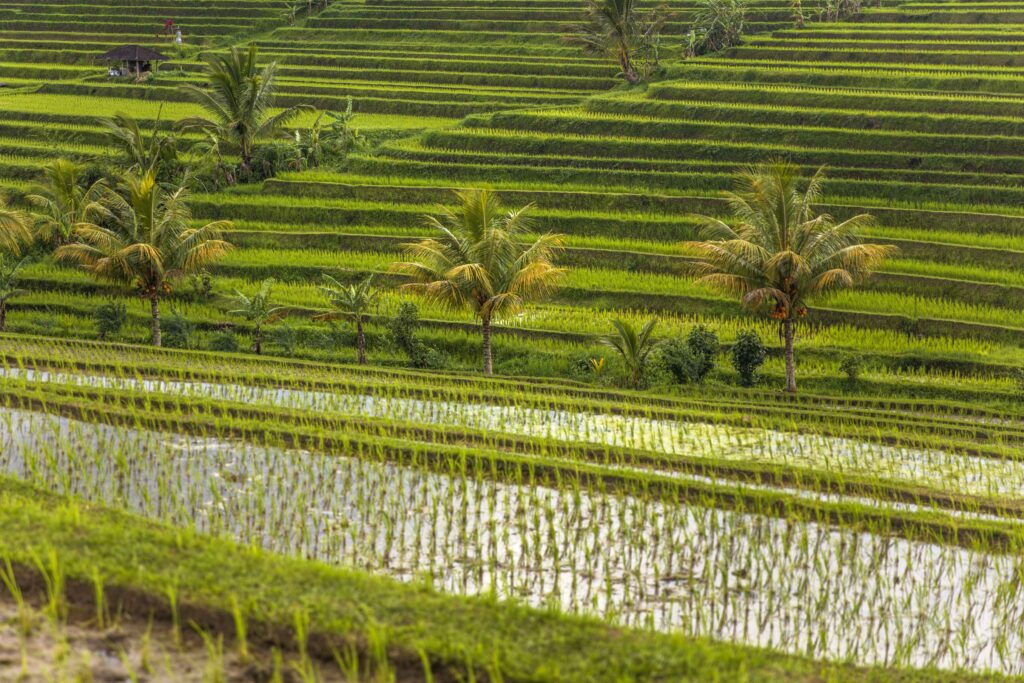
This, the largest rice terraces on the island of Bali, and the largest among the other rice-producing islands of Indonesia, covers over 600 hectares of land.
The name “Jatiluwih” means “beautiful teak” in Balinese and you can see teak trees dotted around the plantations giving them structure. They call it Jatiluwih Green Land because it really is a green land.
You can wander through any rice field that appeals to you and if you arrive at the right time of year, you can meet local farmers harvesting or planting their crops.
You can take some spectacular photographs for your Instagram feed here at Jatiluwih Rice Terraces and we recommend that photographers bring a tripod, an ND filter and a circular polarizer too to get the best out of the photographic opportunity.
The Jatiluwih Lookout
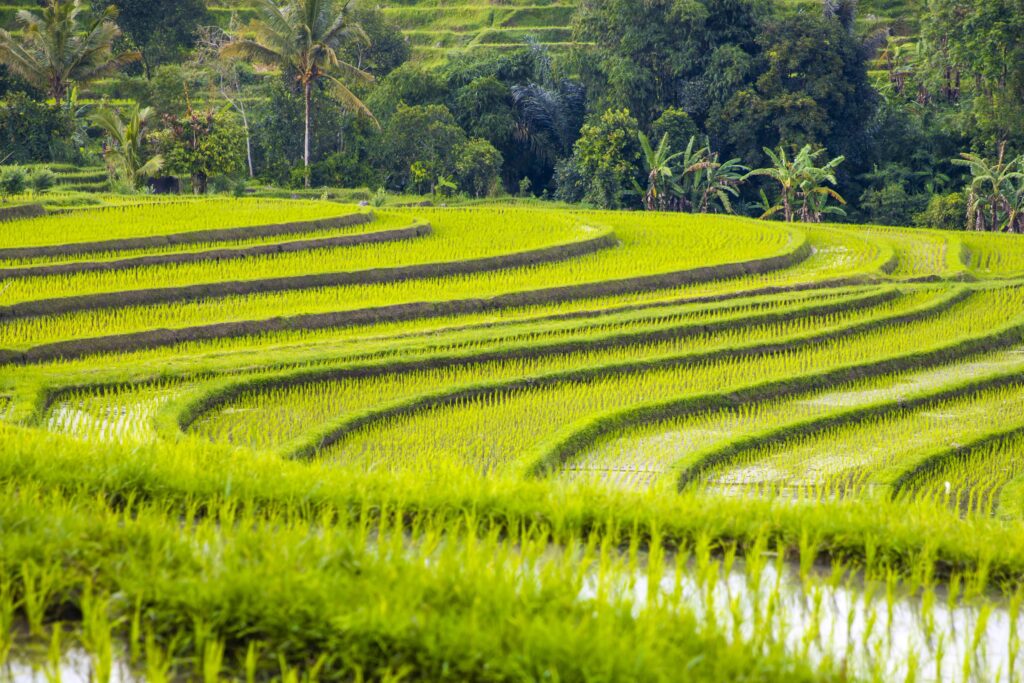
We’d recommend that when you first arrive at the rice fields that you head to the Jatiluwih Lookout. This is a great place to get your bearings and get your first fantastic photograph of the day too.
You can look out over the fields and paddies and really appreciate just how big this area is.
The Subak Rice Irrigation System
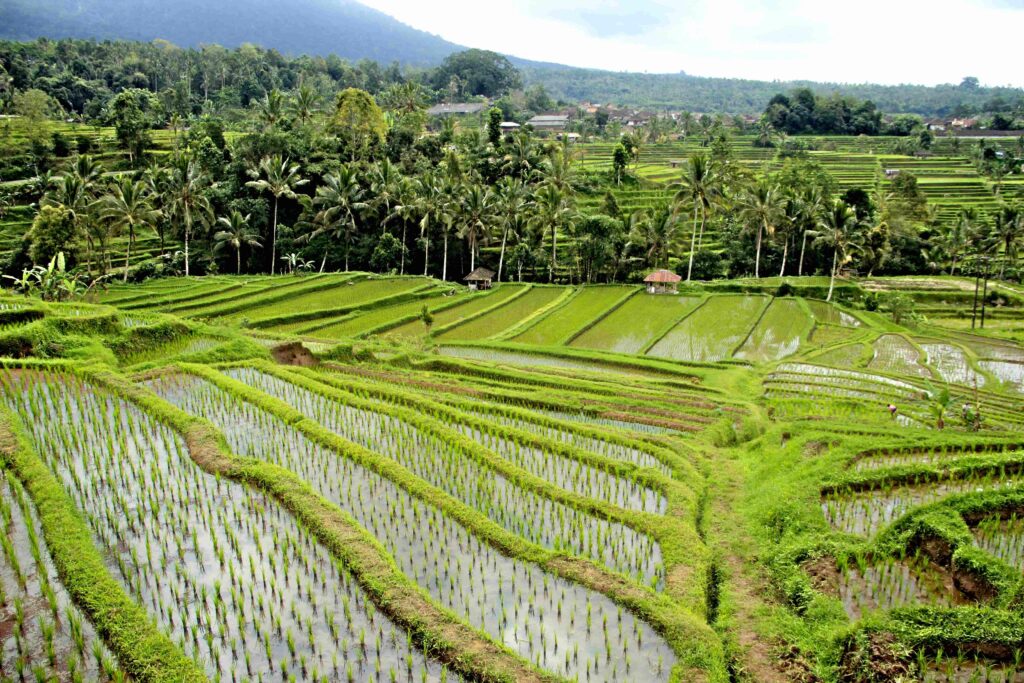
One of the most amazing things at this site is the water management (or method of irrigation.
Rice fields require a lot of water and back in the 9th century, some incredibly clever Balinese engineers did more than just work out how to deliver water to a rice plant’s roots.
The Subak system covers an area of over 20,000 hectares (that’s about 50,000 acres) and there is an important role for Bali’s temples to play in this system too.
Religion And The Subak System
Subak is not just its irrigation paths but instead was constructed for combining sacred traditional values with agriculture.
The system is meant to bind Bali’s agrarian workers, first to the community centre (the “Bale Banjar”) in each village and then to the temples and priests of Bali.
The system is operated under the authority of the priests in Bali’s water temples.
They use the Tri Hita Karana philosophy which guides every aspect of Balinese Hindu life to provide their guiding principles.
That is they consider the relationship between the people, their gods and the land by bringing together the spirit world, the human world and the natural world.
There are unique cultural traditions resulting in the way they maintain harmonious relationship between the elements of this system and priests will regularly conduct rituals to improve the working of the system.
The Components Of The Subak System
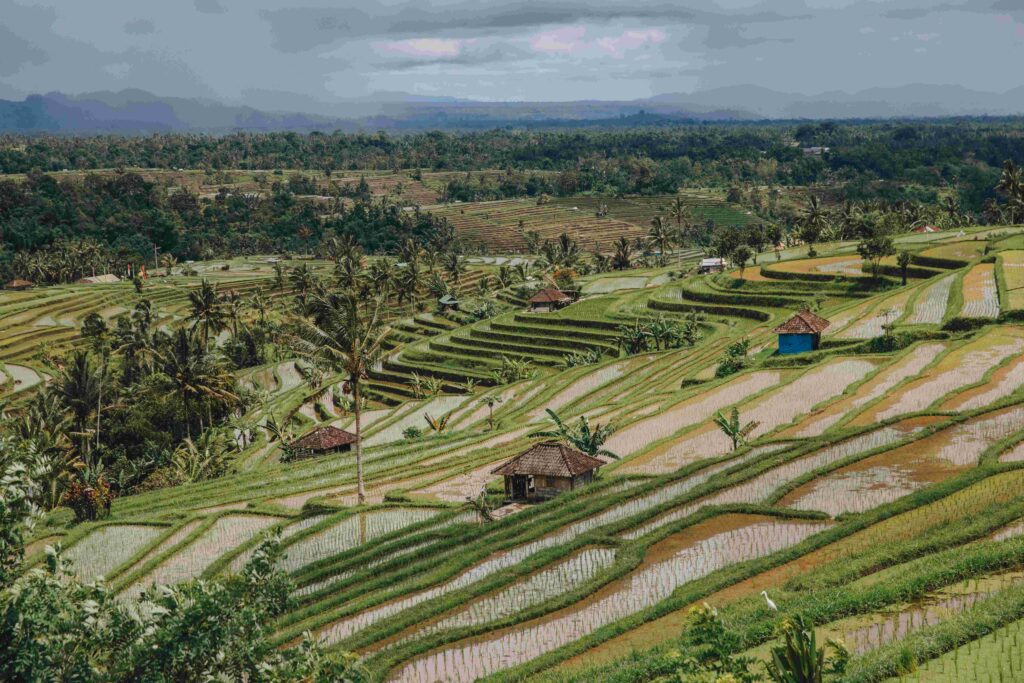
The Subak system uses forests to protect the water supply that is fed to the terraced rice paddy landscape and it connects the fields with canals, tunnels and weirs and to villages and temples too.
The water begins at the temples flowing from rivers and springs and then provides water to vast expanses of the country.
Important parts of this system include the Pura Ulun Danu Batur, the temple in North Bali, near the Mount Batur crater lake – this is considered to be the source of all water in Bali.
The Pakerisan River, the Subak system around this river is the oldest known version of this traditional method preserved throughout the ages.
And the Subak landscape of Catur Angga Batukaru which is what waters every rice field you will see in Jatiluwih.
The Subak system around the regional water temple, Pura Taman Ayun, is considered to be the largest expansion of the system in history and that took place in the 17th century!
The mountain temples and water temples hold festivals to ensure that this system operates all year round and serves the people of Bali’s agricultural needs whenever they need it.
The UNESCO Rating Of The Subak System
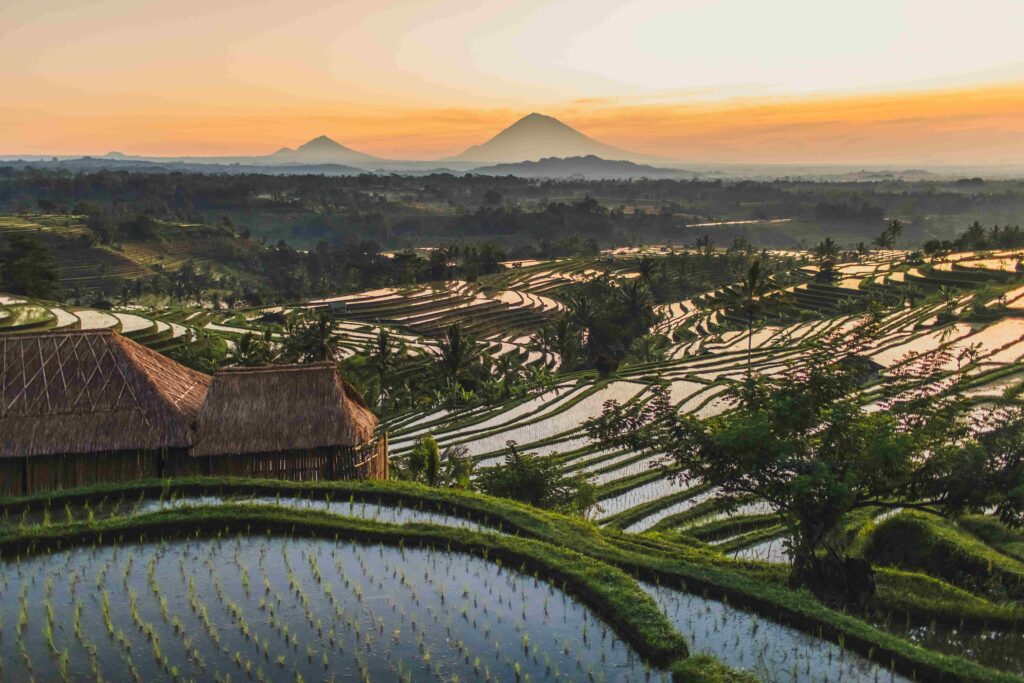
UNESCO’s World Heritage site list has incorporated the Subak System since 2012.
In fact, it’s the only UNESCO World Heritage site in Bali as the local government withdrew all other sites in the nation from the UNESCO list for heritage site status!
It was recognized for its outstanding universal value of cultural and natural properties which deserve to be protected for the benefit of the human race!
Things To Do At Jatiluwih Rice Terraces

The central coastal regency which provides a home for the Jatiluwih Rice Terraces is not a destination for those seeking parties. It’s a place to get in touch with Bali’s cultural landscape and flowing hillside topography.
Many people only come to this part of Bali on a day trip and barely stay long enough to jump out of their vehicle and take a few photos before they head off to their next stop.
However, if you want to enjoy the area in full, there are things you can do here including:
Rice Field Treks

Without a doubt, if you’re in the area during rice growing season the best thing you can do is take a long stroll among the rice plants.
You can appreciate the tropical climate, peaceful atmosphere and the Balinese creative genius that led to the creation of the irrigation system (it really is an impressive communal water system) and see the village cooperatives at work.
There are organized treks in this area, but you probably don’t need to join them, just find somewhere you want to walk and walk.
Cycling Tours
You can arrange a cycling tour of the area too (you can contact the Bali Res Centre – as mentioned in the FAQ below – to do this).
It’s not always easy going on mountain bikes in the rice terraces but it is free of other traffic, which makes it safer than cycling on Bali’s roads.
Yeh Hoo Waterfall & Jatiluwih Waterfall
These two waterfalls are very close to each other and they’re both quite easy to get to.
Yeh Hoo Waterfall is the better-known of the two and has a pleasant pool for those who want to bathe there.
We think it’s the best place on the entire mountain to enjoy cooling down in a natural setting.
Farm Life/Exploring The Balinese Outback

You can also wander into the local villages and find out more about the pace of life and see what people do there.
However, people in these areas tend to speak the Balinese language only and you may not be able to communicate very easily.
Sunrise Spectacle (Early Birds Only)
This area and the rice plants look amazing in the early light of day and golden hour is, without a doubt, the best time of day for photographers.
If you’re prepared to get up at around 5.30 a.m. you will be very glad that you did.
It’s a very peaceful time too and you can usually only hear the local bird life and the chirping of crickets.
The Subak Museum
This lovely museum was opened in the 1980s to help people better understand the Subak system. It’s only 15,000 IDR to get in when it’s open.
Note: This museum is temporarily closed for refurbishment and other works as we go press. That means it’s important to try and contact the museum before your visit to ensure it’s reopened.
Where Is It? Jl. Gatot Subroto No.5b, Banjar Anyar, Kec. Kediri, Kabupaten Tabanan, Bali 82121, Indonesia
Where To Stay Near Jatiluwih Rice Terraces
Batukaru Coffee Estate
This resort is halfway up the Batukaru mountain with the best view of the Jatiluwih rice terraces that we can think of and it’s also a coffee plantation with great breakfast coffee.
Where Is It? Banjar Gunung Sari Desa, Jatiluwih, Kec. Penebel, Kabupaten Tabanan, Bali 82114, Indonesia
Bhuana Agung Villa & Restaurant
This is a very budget-friendly villa operation which is a short walk from the local restaurants and not too far from the rice terraces.
Where Is It? Jalan Raya Jati Luwih, Jatiluwih, Tabanan, Jatiluwih, Kec. Penebel, Kabupaten Tabanan, Bali 82152, Indonesia
Sang Giri Mountain Glamping Resort
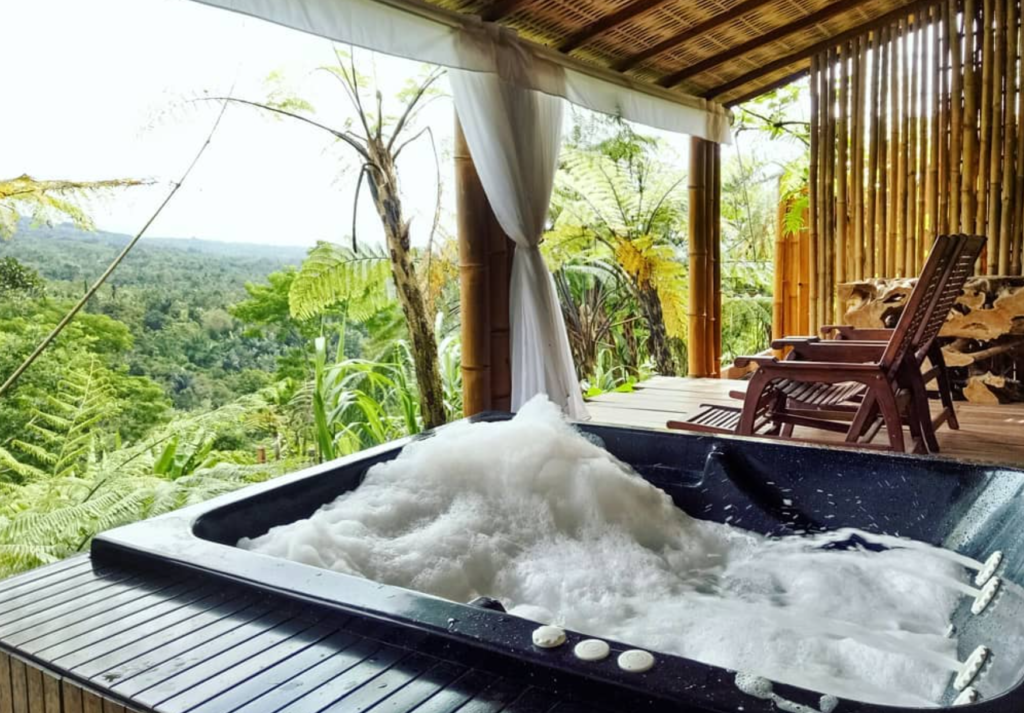
The tents are comfortable, the views are amazing and they offer a huge range of activities here and a great onsite restaurant.
Where Is It? Jalan Sang Giri Hills, Jatiluwih Kangin – Pura Luhur, Jatiluwih, Kec. Penebel, Kabupaten Tabanan, Bali 82152, Indonesia
Adhi Jaya Suite
This family-run backpacker venue is clean and comfortable and has good access to local amenities.
Where Is It? J4JJ+44G, Jalan, Kawan, Jatiluwih, Penebel, Tabanan Regency, Bali 82152, Indonesia
Kubu D’Ume Homestay
The rooms have lovely private balconies and fantastic views of the local area and it’s about as close to the rice terraces as you can get.
Where Is It? J45C+2VW, Jl. Batu Luwih Kawan, Mengesta, Kec. Penebel, Kabupaten Tabanan, Bali 82152, Indonesia
Where To Eat At Jatiluwih Rice Terraces
Gong Jatiluwih Restaurant
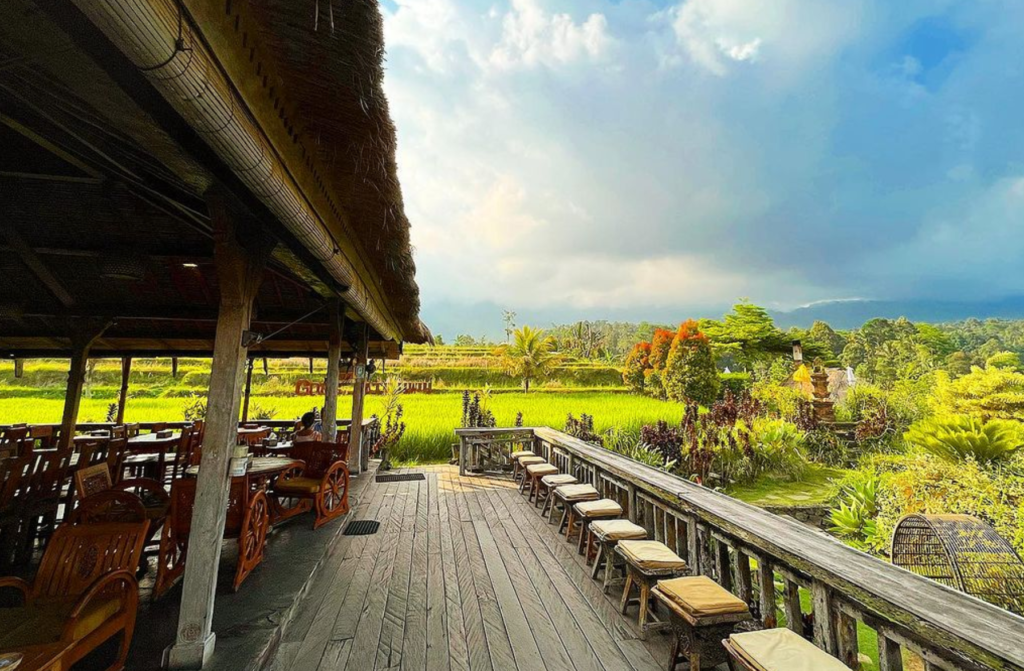
This is a decent buffet restaurant with the best view in the area. They sometimes also have an a la carte menu, but sometimes it’s not available.
Where Is It? Jl. Jatiluwih Kawan No.88, Jatiluwih, Kec. Penebel, Kabupaten Tabanan, Bali 82152, Indonesia
J Terrace Restaurant
If you love Bebek Goreng (fried duck) you will love this place which has a very pleasant view over the local rice terraces.
Where Is It? Jatiluwih, Penebel, Tabanan Regency, Bali 82152, Indonesia
Batu Karu Kopi
This is a lovely little coffee shop that offers snacks and a local cuisine line too. We found the breeze here to be very welcome as we enjoyed our sumptuous view of the area.
Where Is It? Jl. Batu Luwih Kawan, Jatiluwih, Kec. Penebel, Kabupaten Tabanan, Bali 82152, Indonesia
Waroeng Wayan Jatiluwih (or Warung Wayan Jatiluwih)
Cheap and tasty satay is the order of the day here. Please note: they only take cash at this place, no cards.
Where Is It? Jl. Batu Luwih Kawan No.259, Jatiluwih, Kec. Penebel, Kabupaten Tabanan, Bali 82152, Indonesia
Warung Dhea, Jatiluwih
There’s a small buffet and an a la carte menu here and their standards seem to have really improved in the last couple of years. It’s great value.
Where Is It? J4JH+XXP, Jalan, Jatiluwih, Kec. Penebel, Kabupaten Tabanan, Bali 82152, Indonesia
Warung Bubur Betutu Beras Merah Jatiluwih (Green Talas)
Excellent local meals with an emphasis on locally grown rice. You can’t go wrong here.
Where Is It? Jl. Batu Luwih Kawan No.5, Jatiluwih, Kec. Penebel, Kabupaten Tabanan, Bali 82152, Indonesia
Note: Billy’s Terrace Cafe mentioned in so many articles about the rice terraces has been permanently closed.
Things To Do Near Jatiluwih Rice Terraces
Angseri Hot Spring
If you love the idea of bathing in a hot spring, you will love this place which is quite off-the-beaten-path.
It’s super cheap and the entry fee includes use of the private pools.
Where Is It? J5W4+GFX, Angseri, Bangli, Kec. Baturiti, Kabupaten Tabanan, Bali 82191, Indonesia
Batukaru Mountain Range/Gunung Batukaru
The Pura Luhur temple is a great starting place for a simple mountain trek. The Batukaru mountain range is rather easier to climb than many other mountains in Bali.
Where Is It? M37Q+W62, Wongaya Gede, Penebel, Tabanan Regency, Bali 82152, Indonesia
Belulang Hot Spring

This is another volcanic hot spring which is very cheap to enter. However, the site isn’t that well-maintained.
Where Is It? Mengesta, Penebel, Tabanan Regency, Bali 82152, Indonesia
TASTA Tabanan Wildlife Park (Or Taman Satwa Tabanan or Tasta Zoo)
This is a small local zoo that is trying its best to participate in local conservation programs but there are some concerns about the size of the enclosures.
Where Is It? Br. Tegeh, Angseri, Kec. Baturiti, Kabupaten Tabanan, Bali, Indonesia
The Blooms Garden (and Windmills)
If you like windmills and flowers, this is going to blow your mind. It’s one of the most beautiful places in Bali.
Where Is It? Br. Batusesa, Candikuning, Baturiti, Tabanan Regency, Bali 82191, Indonesia
FAQs
What’s The Difference Between Jatiluwih And The Tegallalang Rice Terraces?
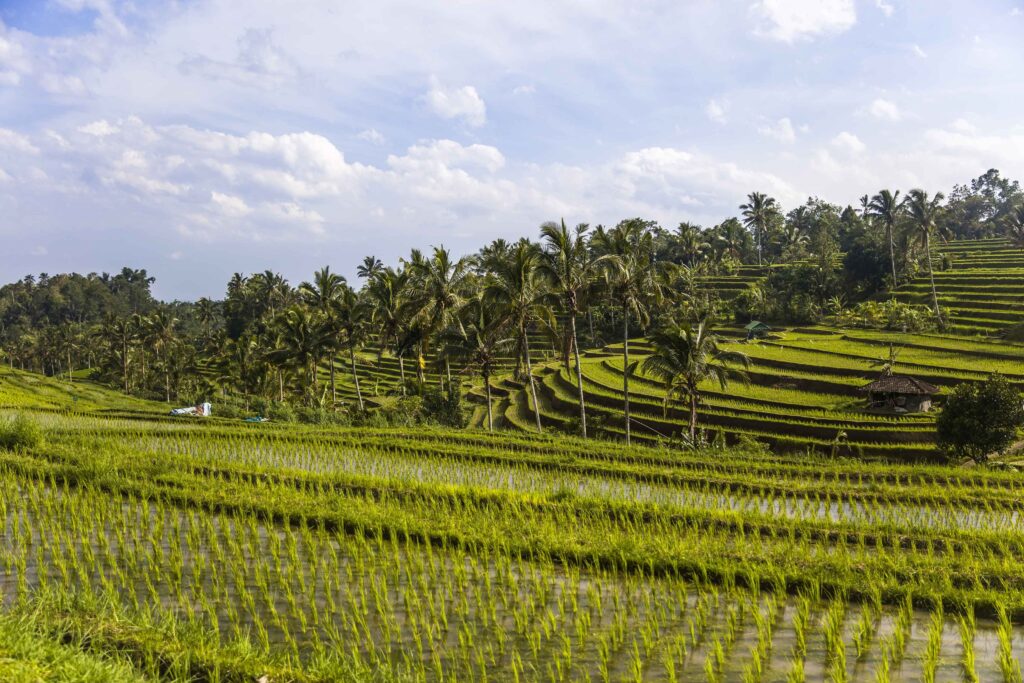
The Jatiluwih Rice Terraces in Bali are much harder to get to than the Tegallalang Rice Terraces, that’s the first difference and one that often sees visitors opt to visit Tegallalang. After all, who wants to spend hours of extra travel time, right?
However, Jatiluwih is a superior experience in most ways to Tegallalang. The Jatiluwih Rice Terraces cover a much larger area and the rice terraces themselves are gently sloping, rather than on steep inclines as they are at Tegallalang.
The paths for walking through the Jatiluwih Rice Terraces are often paved (though some of the more remote areas still have dirt paths) whereas the paths at Tegallalang are all dirt paths.
The Jatiluwih Rice Terraces offer spectacular volcano views (which look great in your Instagram photos) and no such views are available at Tegallalang.
However, the Tegallalang terraces do have a “Bali Swing” and there’s no swing at the Jatiluwih Rice Terraces.
The biggest difference, however, is in the rice itself. The Tegalalang Rice Terraces in Bali have only one kind of rice, white rice. The Jatiluwih Rice Terraces, on the other hand, have white, red and black rice types.
Other differences include more restaurants serving international food at Tegalalang Rice Terraces, but you may have to pay more just to get to them as there’s no unified entrance fee for these rice terraces and you get charged for each section you visit, whereas the Jatiluwih Rice Terraces have a single entry fee for everywhere.
Jatiluwih Rice Terraces is in a much nicer area to stay overnight in, mind you, and staying overnight improves your chances of seeing the clouds clear to get a great view of the volcanoes.
What Is The Most Famous Rice Terraces In The World?
The most famous rice terraces in the world are probably the Banaue Rice Terraces in Ifugao in the Philippines. They are so breathtakingly pretty that they are often referred to as “the 8th natural wonder of the world”.
However, they are quite hard to get to with no local airport and they are a very long drive from Manila or Clark airports.
Jatiluwih Rice Terraces are the most famous rice terraces in Bali and are, much easier to get to than Banaue. They are also spectacularly attractive in their own right.
How To Book A Trip To Jatiluwih Rice Terraces?
If you want to see the Jatiluwih Rice Terraces in Bali or any other part of Bali, we recommend that you contact the lovely people at Bali Res Centre .
That’s a locally owned and operated travel agency with a focus on Balinese travel. That means you will always get the best places to stay, the finest tours and the most competitive prices.
Best of all when you book with Bali Res Centre, it means that your holiday money remains in Bali rather than being sent overseas to enrich a multinational entity.
Final Thoughts On The Rice Fields And Lush Green Rice Paddies Of Jatiluwih
The Jatiluwih Rice Terraces are something truly special to enjoy in Bali and it’s worth the long trip to get to them.
There are very few places on Earth where people are still as connected to the land as they are in this part of Bali. You’ll enjoy fresh air and peace as you drink in the spectacular views of the area from any part of the village or surrounding rice terraces.
















